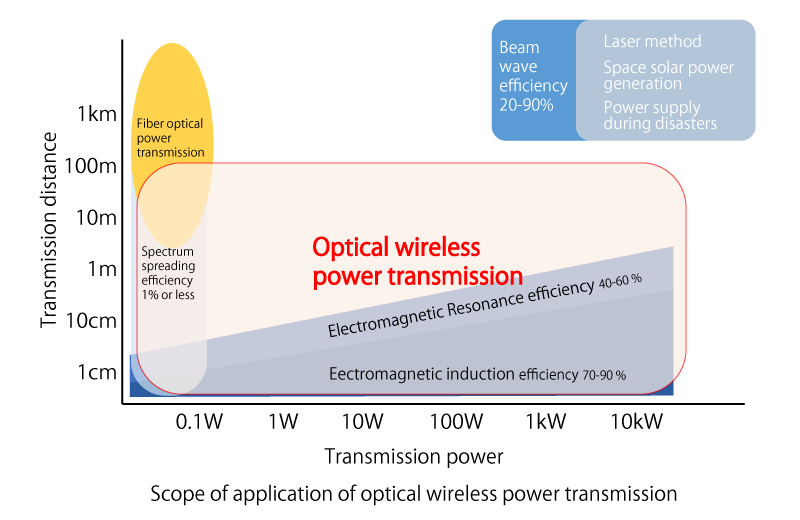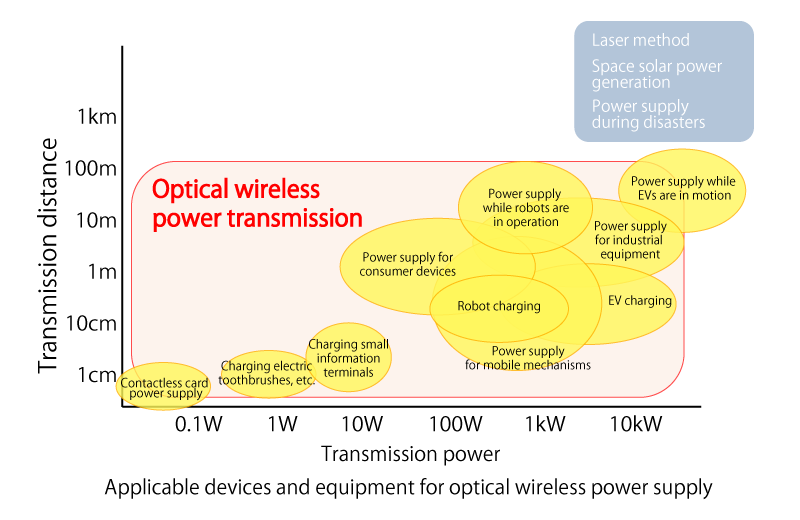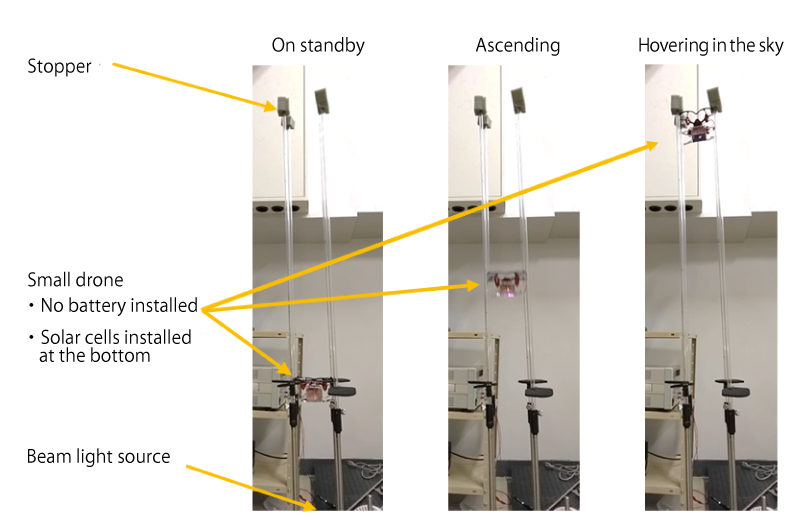-
Optical wireless power transmission and lens array


Isuzu Glass Lens Array, one our main products, is currently being applied for optical wireless power transmission.
Associate Professor Miyamoto Tomoyuki of Laboratory for Future Interdisciplinary Research of Science and Technology (FIRST), Institute of Innovative Research (IIR), Tokyo Institute of Technology, who is leading the Study Group of Optical Wireless Power Transmission, informed us about the latest information of this system in 2024.
What is optical wireless power transmission?
It is a type of supplying electricity method that uses light, in which a light beam emitted from a light source travels through space and is converted into electrical energy by a receiver to supply power (light source here refers to an LED or laser). As it is a technology that transmits power wirelessly without using wires, cables, or outlets, it allows for greater freedom of installing devices and equipment, and by reducing wiring, give the space a cleaner look. As shown in the figure below, optical wireless power supply covers a wide range of areas among wireless power supply methods, and its long transmission distance and high transmission power make it suitable for devices and equipment of high power consumption. (Quoted from the wesite of Study Group of Optical Wireless Power Transmission)



Optical wireless power supply image (power supply experiment using a small drone) (provided by Associate Professor Miyamoto) A small drone was prepared with a solar cell mounted on the bottom instead of a battery. The emitted beam of light was converted into electrical energy by the light receiving section, which allowed the drone to successfully levitate.
Effectiveness of flyeye lenses
In higher output environments, for example when using multiple light sources, it is necessary to irradiate the solar cells installed in the light receiving part of the power supply system with a beam of light as uniformly as possible. This is where the "function of producing uniform light" of the flyeye lens comes into play. Also, by preventing localized light exposure, it also helps to prevent heat dissipation in the system. Furthermore, flyeye lenses are also useful for correcting the position of the light receiving part if the light receiving position is misaligned when it enters the light receiving part.These functions of the flyeye lens are playing a very important role in optical wireless power transfer.
Current status of optical wireless power supply systems
- ・Optical wireless power supply to many small devices
IoT has many small devices, which are difficult to wire and have issues with charging batteries. If optical wireless power supply can be used to remotely supply power and charge devices, the use of many small devices will expand. By equipping the device with a flyeye lens, precise control of the light beam is no longer necessary.
- ・Use for charging cars in-motion
Cars can run with a laser of about 10kW used for laser processing, and if charging can be done while driving, the battery capacity of electric cars can be reduced to about 1/10 of the current capacity. Recently, there are a lot of topics about in-motion power supply using electromagnetic induction to supply power, but it is necessary to embed a large number of electromagnetic induction coils in the road, which leads to huge construction costs. On the other hand, optical wireless power supply is considered to have an advantage in terms of cost, since it can be installed at intervals of over 100 meters and can be installed in road lighting.As for in-motion charging, it is thought that it is easier to enter the market by using it for Automatic Guided Vehicle (AGVs) in warehouses. Currently, when considering the charging time, the number of AGVs actually in operation is reduced to about 1/3, so a very large number of AGVs are required, but if charging while driving becomes possible, it can be said that both the battery capacity and the number of required vehicles can be reduced. However, since most places have only recently introduced it, it is expected that it will be some time before demand for switching arises.
- ・Underwater optical wireless power supply
When using optical wireless power supply underwater, multiple light sources are used to increase the amount of power supply. However, water currents can make the light receiving position unstable, and the light may not reach the solar cell properly. In these cases, it is said that using a flyeye lens is effective. (In clear water, blue light can reach 20 to 30 meters.)
- ・Space optical wireless power supply (JAXA)
Since it is not possible to bring heavy electric wires into space, microwaves or light are effective for power supply. This is where optical wireless power supply technology may be useful. It is said that there is water on the moon, but it is speculated to be inside craters, where are not exposed to sunlight 24 hours a day, 365 days a year. Since sunlight cannot be used for exploration in such places, optical wireless power supply technology using laser light is being considered, and Tokyo Institute of Technology is participating in this project. (It is recognized that using a flyeye lens is effective in shining light on a moving probe.)
- ・Enterprise participation
Major telecommunications companies are also studying optical wireless power transfer systems and developing their applications. Although they are studying systems aimed at space solar power generation and partnering with overseas companies, they need companies that can manufacture the parts and equipment to commercialize the system.
- ・Conferences
The Optical Wireless Power Conference (OWPT), which was launched in Japan in 2019 as the world's first, is held annually, and a paper presentation and conference are planned at Photonics West 2025 to be held in California, USA in January 2025.


